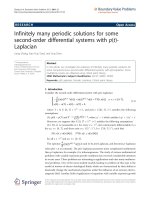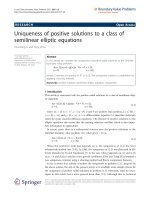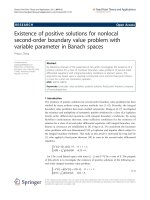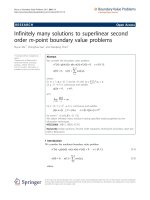Báo cáo hóa học: " Infinitely many sign-changing solutions for a Schrödinger equation" potx
Bạn đang xem bản rút gọn của tài liệu. Xem và tải ngay bản đầy đủ của tài liệu tại đây (245.97 KB, 6 trang )
REVIE W Open Access
Infinitely many sign-changing solutions for a
Schrödinger equation
Aixia Qian
Correspondence:
School of Mathematic Sciences,
Qufu Normal University, Qufu
Shandong, 273165, P. R. China
Abstract
We study a superlinear Schrödinger equation in the whole Euclidean space ℝ
n
.By
using a suitable sign-changing critical point, we prove that the problem admits
infinitely many sign-changing solutions, under weaker conditions.
Keywords: Schrödinger equation, sign-changing critical point, (w*-PS) condition
1 Introduction
In this paper, we consider the following Schrödinger equation,
−u + V(x)u = f (x, u), x ∈ R
N
u(x) → 0, |x|→∞.
(1:1)
In order to overcome the lack of compactness of the problem, we assume that the
potential V (x)hasa“good” behavior at infinity, in such a way the Schrödinger opera-
tor -Δ + V (x)onL
2
(ℝ
N
) has a discrete spectrum. More precisely, we suppose
(V
1
)V ∈ L
2
l
oc
(R
N
)
, V is bounded from below;
(V
2
) There exists r
0
>0 such that for any h>0
meas(B
r
0
(y) ∩ V
h
) → 0, |y|→+∞
,
where meas(A) denotes the Lebesgue measure of A on ℝ
N
,
B
r
0
(y
)
is the bal l centered
at y with radius r
0
and V
h
={x Î ℝ
N
: V (x) <h}.
Of course, V (x) above can satisfy the condition (S
1
)or
((
¯
S
1
)
,
(
˜
S
1
))
in [1], so that the
Schrödinger operator could have the same good properties.
We denote {l
j
} to be the eigenvalues sequence of - Δ+V (x) (see Proposition 2.1 in
Section 2). Set
F( x , t)=
t
0
f (x, s)ds, F (x, t)=f(x, t)t − 2F(x, t
)
.
We assume the following conditions.
(f
1
) f : ℝ
N
× ℝ ® ℝ is a Carathéodory function with a subcritical growth,
|f
(
x, t
)
|≤c
(
1+|t|
s−1
)
, t ∈ R, x ∈ R
N
,
where s Î (2, 2*), f(x, t) ≥ 0 for all (x, t) Î ℝ
N
× ℝ and f(x, t)=o(|t|) as |t| ® 0.
(f
2
)
lim
|t|→+∞
f (x, t)t
|
t
|
2
=+
∞
uniformly for x Î ℝ
N
.
Qian Advances in Difference Equations 2011, 2011:39
/>© 2011 Qian; licensee Springer. Thi s is an Open Access article distributed under the terms of the Creative Commons Attribution
License ( which permits unrestricted use, distribution, and reproduction in any medium,
provided the original work is properly cited.
(f
3
) There exist θ ≥ 1, s Î [0, 1] s.t.
θF
(
x, t
)
≥ F
(
x, st
)
,
(
x, t
)
∈ R
N
× R
.
(1:2)
(f
4
) f (x, t) is odd in t.
Let us point out that, under our assumptions on f(x, t), we can assume witho ut loss
of generality that V is strictly positive just replacing V (x)withV (x)+L and f(x, u)
with f(x, u)+Lu, L large enough. We shall prove the following result.
Theorem 1.1 Under assumptions (V
1
), (V
2
), (f
1
)-(f
4
), problem (1.1) has infinitely
many sign-changing solutions.
Remark 1.1 In [2,3], they got sign-changing solutions for elliptic problem with
Dirichlet boundary value. Those abstract results involved a Banach space of continuous
functionsintheHilbertspace,wheretheconehasanonemptyinterior.Thisplaysa
crucial role. While the abstract theory in this paper only involved a Hilbert space,
where the cone has an empty interior.
Remark 1.2 In [4], they showed infinitely many solutions for p-Laplace equation
with Dirichlet boundary value, while we get infinitely many sign-changing solutions
under similar conditions.
Remark 1.3 Equation 1.1 has been studied in [5], where they obtained the existenc e
for sign-changing solutions in a asymptotically case.
Remark 1.4 In [1, §5.3], they also obtained infinitely many sign-changing solutions
for elliptic problem with Dirichlet boundary value, under (AR) condition stronger than
(f
2
) and (f
3
) above.
Remark 1.5 In [1, §6.4], Equation 1.1 has been studied the existence for infinitely
many sign-changing solutions under conditions stronger than ours above.
2 Preliminaries
We consider the Hilbert space
E = {u ∈ H
1
(R
N
):
R
N
(|u|
2
+ V(x)u
2
)dx < ∞
}
endowed with the inner product
(u, v)=
R
N
(uv + V( x ) uv)d
x
for u, v Î E and
norm
||u|| =
(
u, u
)
1
2
. Clearly it is E ≲ H
1
( ℝ
N
). Denote |u|
q
to be the norm of u in L
q
(ℝ
N
). In order to overcome the lack of compactness of the problem, the following pro-
position is crucial.
Proposition 2.1 [1,5] Assume V (x) satisfies condition (V
1
) and (V
2
), or (S
1
)or
(
¯
S
1
)
and
(
˜
S
1
)
in [1]. Then the imbedding E ≲ L
q
(ℝ
N
) is continuous if q Î [2, 2*] and com-
pact if q Î [2, 2*[. Hence, the eigenvalue problem
−u + V
(
x
)
u = λu, x ∈ R
N
possesses a sequence of positive eigenvalue
0 <λ
1
<λ
3
< ··· <λ
k
< ··· →
∞
with finite multiplicity for each l
k
. Moreover, the principle eigenvalue l
1
is simple
with a positive eigenfunction
1
, and the eigenfunctions
k
corresponding to l
k
, k ≥ 2
are sign changing.
Qian Advances in Difference Equations 2011, 2011:39
/>Page 2 of 6
Let us consider the functional J : E ® ℝ
J
(u)=
1
2
u
2
−
R
N
F( x , u)dx
.
(2:1)
Then J Î C
1
(E, ℝ) and J’ = id (-Δ + V )
-1
f = id - K
J
. The critical point of J is just the
weak solution of problem (1.1).
The proof if our main results will be obtained by a suitable applications of an
abstract critical point theorem stated in [1]. For completeness, we recall h ere this
theorem.
Let E be Hilbert space w ith norm ||u||, and Y, M be two subspaces of E with dim Y
<∞,dimY - co dim M ≥ 1. Let G be C
1
- functi onal on E with G’(u)=u - K
G
(u)and
P denote a closed convex positive cone of E. Denote ±D
0
by open convex subsets of E,
containing the positive cone P in its interior and K ={u Î E : G’(u) = 0}, K[a, b]={u
Î K : G(u) Î [a, b]}. Set D = D
0
∪ (-D
0
), S = E\D. In applications, D contains all
positive and negative critical points, and S includes all possible sign-changing critical
points. Hence, nontrivial sign-changing solutions can be obtained by different choose
of ±D
0
and S.
Next, we assume that there is another norm || · ||
*
of E such that ||u||
*
≤ c
*
||u|| for
all u Î E,wherec
*
>0 is a constant. Moreover, we assume that ||u
n
- u||
*
® 0 when-
ever u
n
⇀ u weakly in (E, || · ||). Write E = M
1
⊕ M.
Let
Q
∗
(ρ)={u ∈ M :
u
p
∗
u
2
+
u
u
∗
u
+ D
∗
u
∗
= ρ
}
where r >0, D
*
>0, p>2 are fixed constants. Let Q** = Q*(r) ∩ G
b
⊂ S and
γ =inf
Q
∗∗
G
,
where G
b
={u Î E : G(u) ≤ b}, then b ≥ g.
Let us assume that
(A) K
G
(±D
0
) ⊂ ±D
0
;
(A
∗
1
)
Ass ume that for any a, b>0, there is a c
2
= c
2
(a, b) >0 such that G(u) ≤ a and
||u||
*
≤ b ⇒ ||u|| ≤ c
2
;
(A
∗
2
) lim
u∈Y,
u
→∞
= −∞,sup
Y
G =
β
.
In the sequel, we shall consider the following Palais-Smale condition, shortly (w* -
PS) condition.
Definition 2.1 The functional G is said to satisfy the (w * - PS) condition if any
sequence {u
n
} such that {G(u
n
)} is bounded and G’ (u
n
) ® 0, we have either {u
n
}is
bounded and has a convergent subsequence or ∃s, R, b >0 s.t. for any u Î J
-1
([c - s, c
+ s]) with ||u|| ≥ R,||J’(u)|| ||u|| ≥ b. If in particular, {G(u
n
)} ® c, we say that (w*-
PS)
c
is satisfied.
The following results hold (see [1, Theorem 5.6]).
Theorem 2.1 Assume (A)and
(A
∗
1
)
and
(A
∗
2
)
. If the even functional G satisfies the
(w* - PS)
c
condition at lever c for each c Î [r, b], then
K[r − ε, β + ε] ∩
(
E\P ∪
(
−P
))
=
∅
for all ε >0 small.
Qian Advances in Difference Equations 2011, 2011:39
/>Page 3 of 6
3 Proof of the main theorems
From now on, we will denote by N
k
the eigenspace of l
k
.ThendimN
k
<∞.Wefixk
and let E
k
= N
1
⊕ ⊕ N
k
. In order to give the proof of Theorem 1.1, first we state
some useful lemmas.
Lemma 3.1 J(u) ® -∞,as||u|| ® ∞, for all u Î E
k
.
Proof. Because dim E
k
<∞, all norms in it are equivalent, then by (f
2
),
J(u)
||
u
||
2
≤
1
2
−
∫
R
N
F( x , u)
||
u
||
2
dx →−∞
.
Consider another norm ||·||
*
:= ||·||
s
of E, s Î (2, 2*). Then ||u||
s
≤ C
*
||u|| for all u
Î E,hereC
*
>0isaconstantandbylemma2.1||u
n
-u||
*
® 0wheneveru
n
⇀ u
weakly in E. Write
E = E
k−1
⊕ E
⊥
k
−
1
. Let
Q
∗
(ρ)={u ∈ E
⊥
k−1
:
||u||
s
s
||
u
||
2
+
||u||||u||
s
||
u
||
+ D
∗
||
u
||
s
= ρ
}
where r, D
*
are fixed constants.
Lemma 3.2 ||u||
s
≤ c
1
, ∀u Î Q*(r), where c
1
>0 is a constant.
Proof.If||u||
s
® ∞, then so does ||u|| ® ∞. Hence
||u|| ||u||
s
||
u
||
+ D
∗
||
u
||
s
→∞
,
a contradiction.
By (f
1
), there exist C
F
>0, s Î (2, 2*) such that
|
F( x , u)|≤
λ
1
4
u
2
+ C
F
|u|
s
, x ∈ R
N
, u ∈ R
.
(3:1)
Therefore, for any a, b>0, there is a c
2
= c
2
(a, b) >0 such that
J(
u
)
≤ a, ||u||
s
≤ b ⇒||u|| ≤ c
2
.
By lemma 3.1,
lim
u∈Y,
||
u
||
→∞
J(u)=−∞
,
where Y=E
k
. Then, conditions
(A
∗
1
)
and
(A
∗
2
)
are satisfied. We define
sup
Y
G
:= β
.
Let
Q
∗∗
:= Q
∗
(ρ) ∩ J
β
⊂ S,inf
Q
∗∗
J := γ
.
Set P ={u Î E : u(x) ≥ 0 for a.e. x Î ℝ
N
}. Then, P(-P) is the positive (negative) cone
of E and weakly closed. By Lemma 5.4 or Lemma 6.8 [1], there is a δ := δ(b)suchthat
dist(Q**, P)=δ(b) >0. We define
D
(
μ
0
)
:= {u ∈ E : dist
(
u, P
)
<μ
0
}
,
where μ
0
us determined by the following lemma.
Lemma 3.3 Under the assumptions (V
1
), (V
2
), and (f
1
), there is a μ
0
Î (0, δ) (may be
chosen small enough) such that K
J
(±D(μ
0
)) ⊂ ±D(μ
0
). Therefore, (A) is satisfied.
Qian Advances in Difference Equations 2011, 2011:39
/>Page 4 of 6
Proof. Please see Lemma 2.9 of [1] for the similar proof.
Let D := -D(μ
0
) ∪ D (μ
0
), S := E\D. By Lemma 3.3, we may assume Q** ⊂ S.
Lemma 3.4 Let us assume that (V
1
), (V
2
)and(f
2
), (f
3
) hold. Then, the functional J
satisfies the (w*-PS) condition.
Proof. As the sequence {u
n
} such that {G(u
n
)} is bounded and G’(u
n
) ® 0, if {u
n
}is
bounded, then by Proposition 2.1 and the compact imbedding E ≲ L
q
(ℝ
N
), q Î [2, 2*[,
we have {u
n
} possesses a convergent subsequence.
Next to prove another case. If not, there exist c Î ℝ and {u
n
} ⊂ E satisfying, as n ®
∞
J(
u
n
)
→ c, ||u
n
|| → ∞,||J
(
u
n
)
|| ||u
n
|| →
0
(3:2)
then we have
lim
n→∞
∫
R
N
(
1
2
f (x, u
n
)u
n
− F(x, u
n
))dx
= lim
n→∞
(J(u
n
) −
1
2
< J
(u
n
), u
n
>)=c
.
(3:3)
Denote
v
n
=
u
n
||
u
n
||
, then ||v
n
|| = 1, that is {v
n
} is bounded in E. Thus, up to a subse-
quence, for some v Î E, we get
v
n
v
i
nE,
v
n
→ vinL
p
(R
N
), for2 ≤ p < 2
∗
,
v
n
(
x
)
→ v
(
x
)
a.e. x ∈ R
N
.
(3:4)
If v ≢ 0, because ||J’(u
n
)|| ||u
n
|| ® 0, as the similar proof in Lemma 6.22 of [2] or
Lemma 2.2 of [4], we get a contradiction.
If v = 0, by condition (f
3
), as the similar proof in Lemma 6.22 of [2] or Lemma 2.2 of
[4], we also have
R
N
(
1
2
f (x, u
n
)u
n
− F(x, u
n
))dx →∞
,
(3:5)
which contradicts (3.3).
This proves that J satisfies the (w*-PS) condition.
Remark 3.1 Our condition (f
3
)hereisdifferentfrom(P
3
)of[1,Theorem6.14],
which is used to prove the (w*-PS) condition; furthermore, it is more weaker.
Proof of Theorem 1.1. By Theorem 2.1,
K[r − ε, β + ε] ∩
(
E\P ∪
(
−P
))
=
∅
for all ε >0small.Thatisthereexistsau
k
Î E\(- P ∪ P) (sign-changing critical
point) such that
J
(u
k
)=0, J(u
k
) ∈ [r − 1, β +1].
Next, we estimate the
γ =inf
Q
∗∗
J
. Because of Proposition 2.1, we can adopt the similar
method as in [1, p. 67]. Similar to Lemma 2.23 of [1], by choosing the constants D
*
and r, for all u Î Q*(r), we may get
Qian Advances in Difference Equations 2011, 2011:39
/>Page 5 of 6
||u|| ≥
∗
s
min{λ
(
1−α
)(
s−2
)/
2
k
, λ
(
1−α
)/
2
k
} min{ρ, ρ
1/(s−2)
}
.
By Lemma 2.26 of [1], for any u Î Q*(r), we have that
J
(u) ≥
1
8
(
∗
s
)
2
T
1
T
2
,
where
∗
s
, T
1
, T
2
are defined in (2.49)-(2.51) in [1] with p replaced by s Î (2, 2*), a Î
(0, 1) is a constant, and
∗
s
, T
2
are independent of k. In p articular, since l
k
® ∞,we
get
T
1
:= min{λ
(1−α)(s−2)/2
k
, λ
(1−α)/2
k
}→∞, as k →∞
.
Therefore, g ® ∞ as k ® ∞; hence the proof of Theorem 1.1 is finished.
Acknowledgements
The author thanks professor Wenming Zou for his encouragements. This study was supported by the Chinese
National Science Foundation (10726003,11001151), the National Science Foundation of Shandong (Q2008A03) and the
Science Foundation of China Postdoctoral(201000481301) and Shandong Postdoctoral.
Competing interests
The author declares that they have no competing interests.
Received: 2 March 2011 Accepted: 3 October 2011 Published: 3 October 2011
References
1. Zou, WM: Sign-Changing Critical Point Theory. Springer (2008)
2. Li, SJ, Wang, ZQ: Ljusternik-Schnirelman theory in partially ordered Hilbert spaces. Trans Am Math Soc. 354, 3207–3227
(2002). doi:10.1090/S0002-9947-02-03031-3
3. Qian, AX, Li, SJ: Multiple nodal solutions for elliptic equations. Nonlinear Anal T.M.A. 57, 615–632 (2004). doi:10.1016/j.
na.2004.03.010
4. Liu, SB, Li, SJ: Infinitely many solutions for a super elliptic equation. Acta Mathematica Sinica Chinese Series. 46,
625–630 (2003)
5. Salvatore, A: Sign-changing solutions for an asympotically linear Schrödinger equation. Discrete Contin Dyn Syst Suppl.
669–677 (2009)
doi:10.1186/1687-1847-2011-39
Cite this article as: Qian: Infinitely many sign-changing solutions for a Schrödinger equation. Advances in
Difference Equations 2011 2011:39.
Submit your manuscript to a
journal and benefi t from:
7 Convenient online submission
7 Rigorous peer review
7 Immediate publication on acceptance
7 Open access: articles freely available online
7 High visibility within the fi eld
7 Retaining the copyright to your article
Submit your next manuscript at 7 springeropen.com
Qian Advances in Difference Equations 2011, 2011:39
/>Page 6 of 6









